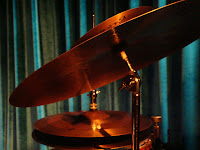
In this latest post, the familiar "two questions" have been answered by the versatile drummer, Mauricio Zottarelli, born in Brazil but for the past few years another fellow resident of Astoria. Mauricio has been a sideman with musicians such as harmonica player Hendrik Meurkens and keyboardist Hiromi but is currently focusing on his own music. There was the recent release of his CD, 7 Lives, and on Tuesday, December 22, he and his band will be gigging at Zinc Bar, located at 82 W. 3rd St., in Greenwich Village, NYC. The first set begins at 9:30 p.m.
Now let's read what Mauricio has to say:
1) Why did you decide on a career in music?
Deep question. Well, I don't think I actually had a choice. You know I think it's kind of a cliche and people say that all the time, but I did try to do other stuff before being a full-time musician. But I always did music, even, you know, as a hobby during weekends and things like that. I was always involved. And according to my parents, I was always playing drums since I was 2 or 3 and I didn't even know what I was doing, but I was always banging on stuff and interested in music from early on. My dad is a keyboard player and mostly by instinct--he didn't really go to school for music, but he loves jazz, and it also seems to be a common thing that happens with all the musicians. People have their parents as a reference and whatever they were listening to in their homes. So that's kind of what happened to me too, but I didn't get into jazz until much later on.
2) What is it you love about jazz that made you decide to focus on that type of music?
Well, basically, I love the freedom that jazz gives us and what you can do with it, and it's a lot more liberating in a way than playing other types of music. You know, it's deeper and it's something that when I started, I was playing heavy rock and I was interested in other types of music, not so much into the jazz thing that my dad was listening to. Then when I went to school and I started to understand more of what was happening, that really switched for me, though I still love heavy rock and still love all sorts of other music. But jazz is really interesting because of that freedom, and because of how you can express yourself in such a way that I don't think you have that freedom in other types of music. Maybe you do but it's a different thing, and that's what I really love about playing improvisational music. Sometimes you can do just anything and you can leave it open to whatever happens. It can be a great experience; it can be frustrating, but that's what I love about it. It's not having to plan everything out beforehand.
For a preview of Mauricio's music, watch his recent video at You Tube by clicking here. Also, be sure to check out his website: www.mzdrums.com.













